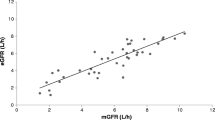Summary
Published data on the renal clearance of creatinine, p-aminohippuric acid (PAH) and kanamycin in relation to glomerular filtration rate (GFR) in patients with various renal diseases were analysed by a physiological model of renal clearance. Fitting of the data by the general linear equation representing the model proposed by Levy [10] resulted in insignificant intercepts with the ordinate, indicating the unsuitability of the model for the detection of tubular secretory activity. Use of this model also did not lead to significant improvement in goodness of fit compared to simple proportionality of renal clearance and GFR. On the other hand, parameter estimates of the physiological model obtained from the data by nonlinear regression analysis revealed statistically significant tubular secretion both of PAH and creatinine. The much lower tubular secretory activity estimated from the kanamycin data did not reach statistical significance. For compounds exhibiting statistically significant tubular secretion, use of the physiologically based relationship between renal clearance and GFR significantly improved the goodness of fit to the data as compared to simple proportionality of both variables.
It is concluded that analysis of the relationship between renal clearance of drugs and GFR using the physiological model of renal clearance can contribute to our knowledge of drug handling by the kidney, and may facilitate drug classification according to total extraction by this organ.
Similar content being viewed by others
References
Tucker GT (1981) Measurement of the renal clearance of drugs. Br J Clin Pharmacol 12: 761–770
Steele TH, Rieselbach RE (1967) The renal mechanism for urate homeostasis in normal man. Am J Med 43: 868–875
Chiou WL (1982) Creatinine XI. Extensive renal tubular reabsorption and secretion in man and its clinical significance. Res Commun Chem Pathol Pharmacol 36: 349–352
Janků I (1993) Physiological modelling of renal drug clearance. Eur J Clin Pharmacol 44:513–519
Kampman JP, Molholm-Hansen J (1981) Glomerular filtration rate and creatinine clearance. Br J Clin Pharmacol 12: 7–14
Shemesh O, Golbertz H, Kriss JP, Myers BD (1985) Liminations of creatitine as a filtration marker in glomerulopathic patients. Kidney Int 28: 830–839
Ross EA, Wilkinson A, Hawkin RA, Danovitch GM (1987) The plasma creatinine, concentration is not an accurate reflection of the glomerular filtration rater in stable renal transplant patients receiving cyclosporine. Am J Kid Dis 10: 113–117
Sjöström PA, Odlind BG, Wolgast W (1988) Extensive tubular secretion and reabsorption of creatinine in humans. Scand J Urol Nephrol 22: 129–131
Schück O (1990) Tubular secretion of creatinine and its plasma concentration. Int J Pharmacol Toxicol 28: 127–128
Levy G (1980) Effect of plasma protein binding on renal clearance of drugs J Pharm Sci 69: 482–483
Orme BM, Cutler RE (1969) The relationship between kanamycin pharmacokinetics: distribution and renal function. Clin Pharmacol Ther 10: 543–550
Schück O, Nádvorníková H, Grafnetterová J, Reitschlägerová V (1985) Relationship between renal clearance of drugs and glomerular filtration rate in patients with chronic renal insufficiency. Int J Clin Pharmacol 23 [Suppl 1]: S42-S47
Bricker NS, Klahr S, Lubowitz H, Rieselbach RE (1965) Renal function in chronic renal disease. Medicine 44: 263–288
Gloff CA, Benet LZ (1989) Differential effects of the degree of renal damage on p-aminohippuric acid and inulin clearances in rats. J Pharmacokinet Biopharm 17: 169–177
Häberle DA, Ruhland G, Lausser A, Moore L, Neiss A (1978) Influence of glomerular filtration rate on renal PAH secretion rate in the rat kidney. Pflügers Archiv 373: 131–139
Hori R, He YL, Saito Y, Kamiya A, Tanigawara Y (1991) Moment analysis of drug disposition in kidney V. In vivo transepithelial transport of p-aminohippurate in rat kidney. J Pharmacokinet Biopharm 19: 51–70
Tisch DE, Huftalen JB, Dickison HL (1958) Pharmacological studies with kanamycin. Ann New York Acad Sci 76: 44–65
Kassirer J (1971) Clinical evaluation of kidney function-glomerular function. New Engl J Med 285: 385–389
Walser M, Drew HH, LaFrance ND (1988) Creatinine measurements often yielded false estimates of progression in chronic renal failure. Kidney Int 34: 412–418
Luke DR, Halstenson CE, Opsahl JA, Matzke GR (1990) Validity of creatinine clearance estimates in the assessment of renal function. Clin Pharmacol Ther 48: 503–509
Rowland M (1984) Protein binding and drug clearance. Clin Pharmacokinet 9 [Suppl 1]: 10–17
Author information
Authors and Affiliations
Rights and permissions
About this article
Cite this article
Janků, I., Zvara, K. Quantitative analysis of drug handling by the kidney using a physiological model of renal drug clearance. Eur J Clin Pharmacol 44, 521–524 (1993). https://doi.org/10.1007/BF02440851
Received:
Accepted:
Issue Date:
DOI: https://doi.org/10.1007/BF02440851




